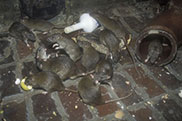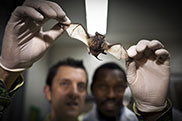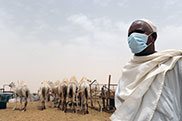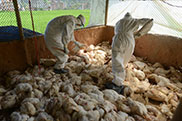 Orlando Sierra/AFP/Getty Images
Orlando Sierra/AFP/Getty Images
Article
An increase in the animal population in urban areas has led to renewed concerns about the impact of disease on humans.
Learn the why behind the headlines.
Subscribe to the Real Truth for FREE news and analysis.
Subscribe Now“Please don’t feed the raccoons.” What was once good advice is now the law in more and more communities—and for good reason. Depending on where you live, your city or town may be under siege by an overabundance of the ringed-tailed critters.
In Germany, over one million raccoons (a species introduced to the nation in the 1920s) are overrunning a country known for precision and cleanliness. The pests routinely rifle through garbage cans, eat food intended for pets, and pilfer scraps from backyard barbecue grills.
During the spring of 2013, an estimated 71,071 raccoons were killed by residents—3,365 more than the year before—according to the German Hunting Association. Yet this counterattack has done little to combat the “furry blitzkrieg.”
Japan has not fared much better. The “animal that scratches with its hands” (raccoon is derived from the Native American for this phrase) is causing irreparable damage, such as mutilating 80 percent of the nation’s temples, many of which are thousands of years old. They claw, scratch and chew dens into the ancient structures, and cause even more damage with urine and feces.
 Thinkstock
Thinkstock
Raccoons are just one species of animal multiplying in human environments. Media outlets now regularly feature stories on the overpopulation of deer, snakes and even domesticated animals such as dogs and cats.
A Time article spoke to this sudden emergence in the U.S.: “We have too many wild animals—from swine to swans. Thirty million strong and growing, the population of white-tailed deer in the U.S. is larger today than it was when Columbus sailed the ocean blue…They gobble up crops and vegetable gardens, dart into traffic and spread tick-borne diseases. Then there are the wild hogs. From a little herd imported to feed explorer Hernando de Soto’s 16th century expedition, some 5 million feral pigs are rooting through city parks and private lawns in 48 of the 50 states.”
The article continued naming beavers, bald eagles, Burmese pythons, wild turkeys, and coyotes, among others, as part of the growing predicament.
“Whether you’re a Walmart employee in Florida wondering what to do with the alligator at your door, a New Yorker with a hawk nesting on your high-rise or an Ohio golfer scattering a flock of Canada geese, you now live, work and play in closer proximity to untamed fauna than any other generation of Americans in more than a century. Even as the human population climbs toward 320 million in the U.S., plenty of other creatures are flourishing too” (Time).
Unless you are directly affected, this expansion can seem trivial. Yet a 2013 report from the Food and Agriculture Organization of the United Nations revealed, “More than seventy percent of emerging infectious diseases in humans over the past few decades have jumped species from animals to humans” (emphasis added).
Read this quote again. Seventy percent. This means that the exponential population growth of animals in dense human populations is more than just a fleeting annoyance. Instead it is a sign of a significant and growing threat to human health.
Find this hard to believe? Keep reading!
Zoonotic Diseases
One disease after another has been traced back to animals. According to the Centers for Disease Control and Prevention (CDC), of the more than 1,400 human pathogens (disease causing agents) recorded, 60 percent of them are zoonotic (zoh-o-NOT-ic), which means they are transferred between animals and people. The term specifically refers to diseases that normally exist in animals but that can infect humans. Zoonoses can be classified as parasites, bacteria, viruses, fungi or prions.
 Thinkstock
Thinkstock
This broad category covers less deadly ailments such as ringworm and Lyme disease to potentially fatal ailments such as HIV/AIDS or anthrax. Just 13 zoonotic diseases are responsible for 2.4 billion cases of human illness and 2.2 million deaths per year.
Many zoonoses exist in what is referred to as a reservoir host, an animal species that can carry the pathogen yet display little to no associated illness. For example, take the aforementioned masked invaders. Baylisascaris procyonis, commonly known as roundworm, affects more than half of North America’s raccoon population. While mostly harmless to raccoons, the jump of the parasite to human beings or other animals can have grave consequences.
In its larval stage, the roundworm penetrates the walls of the small intestines and attacks the central nervous system. A severe enough infection can eventually cause blindness, paralysis and possibly death. There is no known cure.
Even more unnerving is how rapidly the parasite can spread. Inside of its reservoir host, the adult roundworm can lay hundreds of thousands of microscopic eggs per day. Raccoons, which are increasingly showing up in urban areas, leave multiple deposits of the spawns in their fecal matter. A single elimination can have as many as 10 million eggs!
People and animals become infected by either inhaling or somehow ingesting the eggs, which have been known to survive in soil for several years and endure cold winter months. In fact, the most effective way to destroy the eggs is to burn them!
 Brent Stirton/Getty Images
Brent Stirton/Getty Images
One does not have to look far for other acute instances of zoonotic transfer. These include hantavirus, a fatal lung disease discovered in 1993, transmitted to people by mice; West Nile virus, which is spread by mosquitos and infects the brain and spinal cord; and tularemia (rabbit fever), a potentially deadly disease contracted from rabbits or parasites infected by them.
While these and other zoonoses may not represent the next global pandemic, they do offer a clear illustration of how increasing animal populations can lead to higher levels of disease.
Companion Animals
Contact between people and animals with infectious diseases, however, is not limited to chance encounters in the wild. Household pets have also become a threat.
A 2012 report in the Centers for Disease Control’s Emerging Infectious Diseases Journal described the landscape for the developing risk: “Over millennia, cats and dogs have played an integral role in many aspects of human life…This bond with pets has strengthened over the past 50 years. The cat and dog have moved from the barn, into the house, and now, routinely, into the owner’s bed.”
The report stated that an estimated 72 million dogs live in 37 percent of U.S. households and about 81 million cats are in 32 percent of U.S. households. The UK, which was also included in the narrative, has from 16 to 20 million dogs and cats living in approximately a quarter of British households.
The report continued: “More problematic is the vast number of free-roaming or community-owned dogs and cats that receive…less veterinary medical attention and provide a potential huge and uncontrolled reservoir for existing and new emerging zoonoses. Also of concern is the close association that domestic cats and dogs might have with wildlife, resulting in direct or indirect…transfer of pathogens. This association might be particularly likely for free-roaming animals in rural areas, but it is also possible for pets in urban areas where there is potential for interchange of infectious agents between cats and dogs and wild animals such as raccoons, opossums, urban foxes, and wild rodent species.”
 Fayez Nureldine/AFP/Getty Images
Fayez Nureldine/AFP/Getty Images
In Britain, several people caught tuberculosis from their cats, the first recorded cases of their kind. It is believed that the cats contracted it while hunting rodents and other animals involved in a local tuberculosis outbreak.
Harmful organisms can also jump to humans from pets by way of fleas or other parasites an animal brings home and transfers to people’s bed linens or seating areas. Though rare, pet owners have even been infected by allowing their animals to lick them in the face or mouth after they have used their tongues to clean their fur or certain other regions. Even stroking an animal’s fur and then eating without hand-washing can cause disease transfer.
Isolated incidents? Perhaps. But history reveals the zoonotic threat to human health is very real.
World’s Deadliest Diseases
Review just about any list of history’s deadliest diseases. The order and impact of the conditions may vary, yet what is not debatable is that animals were the original source and/or the primary mode of transfer for the majority of ailments.
The following is a sampling of lethal zoonotic diseases. Notice they are among the most familiar and extreme diseases in human history:
- Spanish flu: This deadly influenza virus infected more than half a billion people between January 1918 and December 1920. One of the first forms of H1N1, Spanish flu killed more people than World War I, making it one of the deadliest zoonotic diseases in history. The final death toll is estimated to be between 20-50 million people (some estimates go as high as 100 million deaths).
This flu virus, which surprisingly was on the scene less than 100 years ago, is believed to have started in birds, was transferred to pigs, and then passed to humans after mutating into its deadly form.
Other flu outbreaks since 1918 include one in 1957-58 that killed around two million people worldwide, including some 70,000 in the U.S., and a pandemic from 1968-69 that killed approximately one million, including some 34,000 Americans. More than 12,000 Americans perished during the H1N1 (or “swine flu”) pandemic that occurred from 2009 to 2010 (History.com).
- Bubonic plague: The bacteria, known as the Black Death, killed nearly 25 million people in the 14th century—about one-third of the world’s population at the time. An early symptom of infection is the swelling of the lymph glands, or buboes. Eventually, the bacteria spreads through the body, leading to chills, high fever, gangrene of the toes, fingers, lips and nose, seizures, continuous vomiting of blood, and extreme pain. Once infected, death can occur in as little as four days.
The disease originated as an ordinary bacteria living in the digestive tracts of certain mammals, most likely rodents. It is generally transferred from host to host by fleas, which are not harmed by the pathogen. Once contracted, the bacteria is spread person to person by coughing or sneezing.
Though it was mostly eradicated with antibiotics, a resurgence of bubonic plague in Madagascar in 2013 renewed concerns about future outbreaks.
- HIV/AIDS: This widespread virus is believed to have been originally transferred from chimpanzee blood to human blood in the late 19th century or early 20th century. After the initial transfer, the virus spread rapidly in Africa and eventually made its way to the U.S. It expanded quickly due to being misdiagnosed for decades. By 1981, it was finally recognized as a disease—Human Immunodeficiency Virus (HIV) when first contracted then Acquired Immune Deficiency Syndrome (AIDS) once the virus overwhelms the immune system.
Since the epidemic began, nearly 75 million people have been infected with HIV and approximately 36 million have died. Worldwide, 35.3 million people were living with HIV at the end of 2012, according to the World Health Organization (WHO). While vaccines can slow its development, there is no known cure for the virus.
- Yellow fever: This illness has the unique distinction of being the first human virus ever discovered. Believed to have originated in primates, the dominant method of transmission is through a specific species of mosquito. The virus, which only affects human beings and primates, causes jaundiced or yellowed skin and inflammation of the liver. If untreated, it causes internal bleeding and multisystem organ failure, leading to death.
Despite being studied for so long, yellow fever remains virulent. The WHO estimates 200,000 people are infected annually, leading to about 30,000 deaths.
This sampling of illnesses, along with monkeypox, rabies, anthrax and Q fever to name a few, all serve as a warning of the legitimate impact of animal-to-human disease transfer.
Preventing the Problem
Battling to treat existing diseases and keep old ones at bay requires a vast amount of resources. Therefore, emerging zoonoses only add to the problem.
A Washington Post article elaborated on their increasing danger: “[A high] proportion of human diseases that have emerged in recent decades, such as SARS and Lyme disease, have their origins in animals. And since the 1970s, the emergence of new zoonotic diseases has been accelerating. If we’re watching for the source of the next big epidemic, look to the animals.”
 Sia Kambou/AFP/Getty Images
Sia Kambou/AFP/Getty Images
As advanced as science and medicine have become, zoonoses are developing more quickly than are ways to treat them. Experts are finding it difficult to keep up.
The Lancet, a leading world medical journal stated, “Understanding the ecology of zoonotic diseases at the human being-animal interface is a complex challenge. It requires knowledge of animal and human medicine, ecology, sociology, [and] microbial ecology…”
Specialists refer to this required collaborative effort between multiple disciplines as “One Health.”
Yet this alliance cannot develop as fast as new illnesses appear. Consider the spread of Middle East Respiratory Syndrome (MERS). It came seemingly out of nowhere in 2012, and has killed from one-third up to half of those infected. The origin of the virus has been linked to camels or bats—just another such disease added to the growing list.
Zoonotic diseases can also be unpredictable. Just when you think you have one under control, things can quickly change.
“Some [zoonoses] are widespread and famously lethal, still killing humans by the thousands despite centuries of effort at coping with their effects, concerted international attempts to eradicate or control them, and a clear scientific understanding of how they work,” National Geographic reported. “Others are new and inexplicably sporadic, claiming a few victims…or a few hundred in this place or that, and then disappearing for years.”
Take the Ebola virus that has reappeared in parts of West Africa. It first surfaced in the mid-1970s with various outbreaks occurring over the years. Now, in the midst of a “second wave,” it is being described as “totally out of control.” An infected person starts with a fever, then nausea, vomiting, difficulty breathing, and bleeding inside and outside the body. It is believed to have multiple reservoir hosts including bats, gorillas, dogs and possibly pigs.
The comeback of the Ebola virus demonstrates the difficulty in effectively combating zoonotic diseases compared to other ailments.
National Geographic expanded on the struggle: “Smallpox, [for example], is not a zoonosis. It’s caused by a virus that infects [humans] and, in very exceptional cases, certain nonhuman primates, but not horses or rats or other species…Smallpox could be eradicated because its virus, lacking ability to reside virtually anywhere other than in humans, couldn’t hide. Zoonotic pathogens can hide.”
“When a disease seems to disappear between outbreaks…its causal pathogen may indeed have died out, at least from the region—but then again, maybe not. Maybe it’s still lingering nearby, all around, within some reservoir host. A rodent? A bird? A butterfly? Possibly a bat? To reside undetected within a reservoir host is probably easiest wherever biological diversity is high and the ecosystem is relatively undisturbed. The converse is also true: Ecological disturbance causes diseases to emerge. Shake a tree, and things fall out.”
In short, these “disturbances” are increasing in frequency, leading to increased animal-to-animal contact and ultimately animal-to-human contact. The byproduct is the spread of disease and a threat to basic human health.
Reasons for Increase
The continuous and increasing spread of zoonotic disease has been tied to numerous factors.
One is increased world travel. Man traversing the planet has long been seen as a cause of the spread of disease. Centuries ago, people traveled by land via trade routes carrying goods from one place to another. Often, along with the exchange of goods and livestock, was an exchange of the foreign zoonotic organisms they carried.
Modern transportation has furthered this expansion as people and goods routinely crisscross the globe. Diseased animals are still transported from place to place—though sometimes unintentionally. For instance, scientists believe West Nile Virus made its way to the United States in 1999 by mosquitos hiding inside airplane wheel wells.
 Source:Prakash Mathema/AFP/Getty Images
Source:Prakash Mathema/AFP/Getty Images
Population density and the resulting poor sanitary conditions are also cited as reasons for the rapid spread of sickness. According to populationeducation.org, “…over 50% of the global population lives in urban areas. With more people living in dense conditions, there is frequent contact between more individuals, allowing disease transmission to easily occur.”
Worsening environmental conditions are also believed to have a negative impact. Warmer climates and flooding in some areas have allowed certain ailments to flourish—such as cholera, malaria and dengue fever as the parasites that carry them thrive in these environments.
At the same time, drought can cause just as many problems as “viruses, protozoa, and bacteria can pollute both groundwater and surface water when rainfall decreases” (CDC). The lack of water also leads to diverse animal species congregating at or near diminishing water sources, which causes pathogens to spread to new hosts.
The list of reasons diseases are spreading includes other factors such as people’s worsening diets, poor medical facilities, and overuse of antibiotics.
Another Way to View Disease
Of the problems mankind has to overcome—lagging economies, food shortages, battles over religion, war, among others—disease remains a persistent foe. No amount of effort seems capable of making it go away completely. In fact, the more we do, the worse things seem to become.
Many see human beings as just “another species of animal.” To them, disease is simply a natural element of human existence. Yet a review of Scripture sheds different light on how mankind should view the scourge of disease.
First, understand that when God completed Creation He looked over everything He had done and called it “very good” (Gen. 1:31). This meant that it was perfect. God’s handiwork, including the human body, was made to function without the threat of disease.
The apostle John provided a further glimpse into what God meant when he was inspired to record, “…I wish above all things that you may prosper and be in health, even as your soul [life] prospers” (III John 2). Disease was not intended as a “fact of life.”
Yet the Creator also established bedrock laws and principles for mankind. One such law is the familiar rule of cause and effect: if you do this—you can expect that. Certain actions lead to consequences.
This principle manifested itself early on with a promise that disobedience would ultimately lead to death (Gen. 2:17). This plain statement opened the door for sickness and human suffering as a possibility.
Notice an exchange between God and the children of Israel found in the book of Leviticus in which He further explained the consequences of failing to obey instruction: “And if you will not be reformed by Me by these things, but will walk contrary unto Me; then will I also walk contrary unto you, and will punish you yet seven times for your sins. And I will bring a sword upon you, that shall avenge the quarrel of My covenant: and when you are gathered together within your cities, I will send the pestilence among you; and you shall be delivered into the hand of the enemy” (Lev. 26:23-25).
Pestilence—disease outbreaks—were a consequence of failing to keep God’s commands.
Another warning occurred in Deuteronomy 28: “But it shall come to pass, if you will not hearken unto the voice of the Lord your God, to observe to do all His commandments and His statutes which I command you this day; that all these curses shall come upon you, and overtake you…The Lord shall make the pestilence cleave unto you, until He have consumed you from off the land, whither you go to possess it. The Lord shall smite you with a consumption, and with a fever, and with an inflammation, and with an extreme burning, and with the sword, and with blasting [drought], and with mildew [flooding]; and they shall pursue you until you perish” (vs. 15, 21-22).
Strong words! God not only described a people being pursued by disease, but He also described conditions that allow it to flourish.
Understand. Every instance of sickness and disease should not be viewed as a “curse from God” on a particular individual. Jesus made this principle clear when He said that some suffer not necessarily because of their personal sin but instead “that the works of God should be made manifest [obvious]…” (John 9:1-3).
Yet this does not negate the fact that poor decisions lead to poor consequences. This can be on a national level as was the case with ancient Israel or on an individual level when people disobey certain health principles and become sick, a topic also covered thoroughly in scripture. (For more information on ways to maintain good health and help avoid the onset of disease, read David C. Pack’s informative booklet titled God’s Principles of Healthful Living.)
Unknown to most, though, disease, especially its sudden increase and its connection with animals, has other implications.
Pestilence in Prophecy
As with so many today, those with Christ when He walked the Earth wondered about prophecy—specifically the timing of His Second Coming and signs indicating the end times.
Remarkably, when asked, Jesus was forthcoming in His response. He told the disciples exactly what would occur and what to look for. Included in the “signs” or indications of the end was increased “pestilences” or plagues and disease epidemics (Matt. 24:3, 7).
The key is that there would be an upsurge in disease. This is obvious because disease is an age-old problem. Its proliferation, though, is an indication of what the Bible refers to as the “end of the age.”
God’s Word goes further pronouncing what role animals will play. Read the following from the book of Revelation: “And I looked, and behold a pale horse: and his name that sat on him was Death, and Hell followed with him. And power was given unto them over the fourth part of the earth, to kill with sword, and with hunger, and with death, and with the beasts of the earth” (Rev. 6:8).
The last part of the verse means exactly what it says. During the end times, along with war and hunger, animals will be a key cause of death for many millions either through direct attacks or even more problematic, through the spread of zoonotic diseases—recall Spanish flu killed up to 100 million people and Bubonic plague destroyed one-third of Earth’s population! What is coming will be much more severe.
Mr. Pack summarized the coming impact of disease in his extraordinary book The Bible’s Greatest Prophecies Unlocked! – A Voice Cries Out: “Disease will soon alter the course of history in a profound way. The coming disease pandemics will dwarf all that have previously occurred. Hundreds of millions will perish—and this will not only happen in poor, underdeveloped countries. Horrific epidemics, the likes of which have never been seen, will strike the world’s wealthiest nations—which will collapse from the impact. The ensuing chaos will affect you, and all of your loved ones. Everything around you will change for the worse. Your life will be at risk.”
The pages of Mr. Pack’s book are filled with information that paints a crystal clear picture of what will slam into an unsuspecting world. Among other certainties, it thoroughly explains the Four Horsemen of Revelation, the Mark of the Beast, the Antichrist, and many other biblical concepts that have confused many.
To learn more about what is to come, read this unique volume free of charge.
Studying this book with an open Bible will forever change your view of prophecy—and the role of animals in it.
More on Related Topics:
- Afghan Hunger Crisis Deepens as Aid Funding Falls Short, UN Says
- Israel’s Longest War Is Leaving a Trail of Traumatized Soldiers, With Suicides Also on the Rise
- Maintaining Your Health as You Grow Older
- The Blind to See—Humanity’s Fight to Cure Blindness
- ‘Nightmare Bacteria’ Cases Are Increasing in the U.S.



